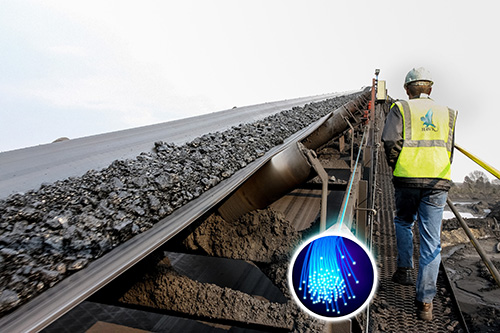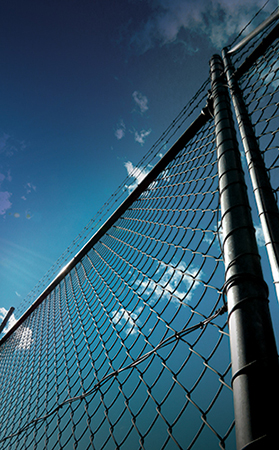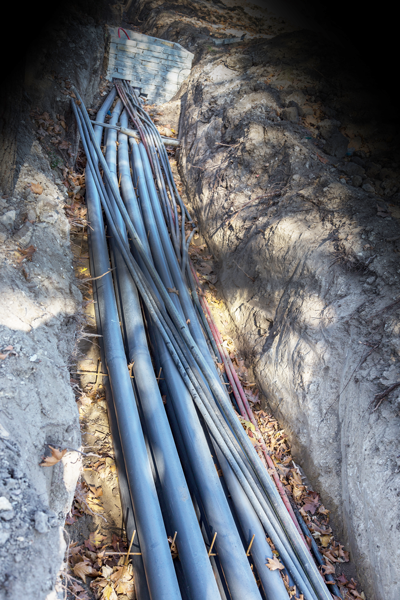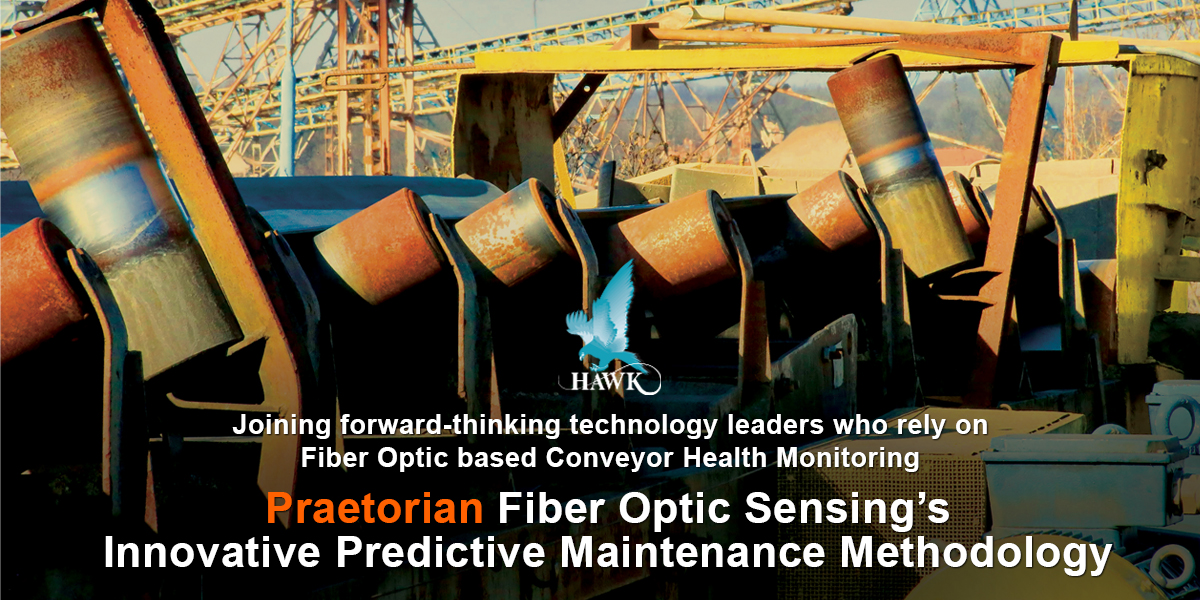Conveyor Condition Monitoring
Despite the difficulties from COVID-19 over the past two years, Hawk Measurement Systems (HAWK) has been working hard with its clients installing Praetorian™ Fiber Optic Conveyor Health Monitoring Systems (CHMS) all around the world, allowing its customers to automatically monitor their conveyor condition and operate conveyors under a predictive maintenance methodology.
Fundamentally, the system provides operators, managers and planners with a daily “hit list” of all monitored idlers for inspection, rather than a monotonous and tiring “walking” or the less effective “driving” of the belts. This failure prediction capability means only the idlers that need it are changed. This targeted approach means both a quicker and more accurate idler changeout methodology requiring significantly less monotonous inspections in and around the conveyor footprint.
Additional advantages include the ability to look at trends to predict failures far into the future and model the number of spares that will be needed months ahead of schedule. 
Return On Investment (ROI)
Specific ROI will vary project depending on the project and will depend on factors including:
- Project size (belt length)
- Existing maintenance
- Program
- Costs
- Optimisation
- Lost production time value
- How the site is operated
In a typical installation on major arterial conveyors, a single unscheduled stoppage prevented often leads to a complete return on investment and is the more realistic ROI model. If looking at reduction of maintenance costs being the only factor for ROI calculation, the reduction of maintenance time for inspection as well as the reduction of early change-outs typically see a ROI payback within one to two years of installation.
How It Works 
HAWK’s Praetorian™ Fiber Optic CHMS monitors idler vibration through a pair of fibre optic cables on the conveyor stringer and puts a pair of ears up against every idler on the conveyor every minute of every day. The system links in with the existing control network to provide a live output to operators of any rapidly deteriorating idlers, as well as automatically providing scheduled reports on idlers that are beginning to fail and may need replacement during upcoming maintenance activities.
Installation
The system can be treated as three separate parts:
- Electrical equipment
- Mounted in a nearby server or HV switch room
- Goes in a new or existing rack
- Deployment (non-sensing) cable
- Runs from the electrical equipment to the sensing cable on the belt

- Cable tray or buried
- Sensing cable
- Mounted to the stinger on each side of the belt
- Mount method based on conveyor type
Kinds of Conveyors
HAWK has current installations on conventional frame, garland and cable (rope) conveyors. Detection and monitoring is a similar process; however, the methodology behind the fixing of the sensing cable to the conveyor structure varies with conveyor type.
System Trials
Yes, it’s actually the primary way HAWK has been doing the installations. HAWK has pre-built trail units that are self-contained in small server racks. HAWK can ship to sites fairly quickly. Once they have arrived onsite, that just needs to be plugged in and connected to the fibre and after a quick calibration they are ready to go. Trials are supplied with the necessary cable, electrical equipment and mounting components to suit about 200m of conveyor belt, which is picked for both ease of access and availability and proximity to a suitable mounting location.
Multiple Conveyors
Multiple conveyors can be connected together end to end in a daisy chain. This is typically a configuration found in arterial overland conveyors such as plant or rail load out feeds. Other more complex conveyor networks such as wheel and spoke configurations can be monitored through routing the cable back and forth along conveyors, allowing for coverage of any configuration of joined conveyors.
The speed of installation depends on the mounting method chosen and the difficulty of access on a given site, but based on field experience, an individual installer can mount between 150m and 300m of fully installed fibre per day. In this way a typical team of eight can work on any given section at a time and achieve 1.2-2.4km of installation per workday.
For larger applications with limited lengths of scheduled downtime, the sensing fibre can be installed in separate sections over multiple shutdowns which can then be joined together at the end of the installation.
Does the system do anything else?
The secondary sensing application that HAWK uses, is for fire detection. This involves stringing a metal cable above the belt to mount another fibre optic cable which is configured to sample air temperature every few seconds along the entire length of the conveyor network. In the event of a fire,the rapid increase of air temperature above maximum ambient temperature indicates a heating event caused by smouldering or open flame. The location extent of the fire is reported as a priority alarm to the connected control system allowing for rapid response.
BY MATHEW COOK | HAWK MEASUREMENT SYSTEMS PRODUCT MANAGER


The Praetorian Conveyor Health Monitoring System (CHMS) is a plant & site-wide single solution for detecting when critical parts of the idler are beginning to fail. The early detection warnings allow operators to control downtime and avoid catastrophic costly unplanned shutdowns. HAWK's Praetorian Fiber Optic Sensing detects abnormalities in conveyor idler performance that other technologies cannot.

The Praetorian Fiber Optic Sensing System can be installed along a fence or perimeter and can detect, identify and report any movements. This system has limitless applications and can be installed on anything from explosive storage areas to farms and ranches. The fast processing speed and pulse rate allow the Fiber Optic System to detect minute interferences that may otherwise go unnoticed. Some examples of detectable activates include intruder movement along a perimeter, intruders cutting or climbing a fence, vehicle movement along a perimeter and digging, excavating or trenching. The Fiber Optic Sensing system is crucial for keeping valuable assets secure and protected.

The Praetorian Fiber Optic Sensing System can be installed on a buried or unburied pipeline and can immediately detect pipeline leakage, ground disturbances, manual and machine excavation, theft, hot tapping and vehicle movement. The Fiber Optic System continually monitors large spans of pipeline, looking for vibration and temperature changes. Once a detection occurs, the system alerts the operator or security personal to the exact location of disturbance in the pipeline. This type of real-time intelligent monitoring is critical to operating efficiently and protecting valuable assets.

The Praetorian Fiber Optic Sensing System can monitor buried and unburied data cables, wires and power transmission lines. Monitoring for wear, damage or corrosion of the cable is extremely difficult and often power failure or data outage is the first sign of a problem. These cables are typically installed in areas that have multiple uses by various stake holders and in the event of a failure can be logistically difficult and expensive to access for repair. The Praetorian Fiber Optic Sensing System can be installed either near the power cables or embedded within the power cable itself. It can monitor disturbances, identify manual and machine excavation, vehicle movement, ground condition assessment and detects hotspots. HAWK’s Fiber Optic Sensing System requires no additional field infrastructure such as power or communication and does not require maintenance or calibration after commissioning.

Tailings Dams are massive structures used all over for the bulk storage of mineral processing wastes. These earthen structures can measure tens of kilometers in length and width and be hundreds of meters tall. In terms of total volume tailings dams are the largest manmade structures in existence. However, over the last 20 years the rate of tailings dams failing has doubled. Failures of tailings dams are perhaps the worst possible case scenario for any mineral extraction operation. Events causing loss of life in the hundreds or even thousands, Environmental fines reaching billions of dollars and the loss of facility infrastructure and production are a confronting prospect. HAWK has developed a solution to prevent tailings dams failure. HAWK's Praetorian Geological Stress Detection System utilizes fiber optic sensing technology for the real time monitoring of field strain within earthen structures. This revolutionary technology uses fiber optic cables that are then inserted into the structure through drilled boreholes. These cables monitor field strain and deflection caused by dam loading and report both the borehole position and depth where the strain or deflection is occurring within the retaining wall structure. Sensitivities achievable with the Praetorian Geological Stress Detection System means that potential issues with ground shift can be detected and intercepted well in advance of visually symptoms of structural issues.

